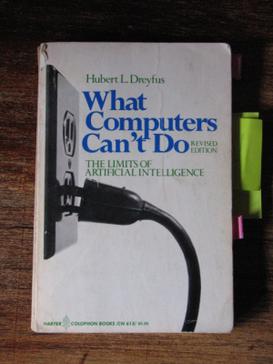Related Research Articles
Artificial intelligence (AI), in its broadest sense, is intelligence exhibited by machines, particularly computer systems. It is a field of research in computer science that develops and studies methods and software which enable machines to perceive their environment and uses learning and intelligence to take actions that maximize their chances of achieving defined goals. Such machines may be called AIs.

Cyc is a long-term artificial intelligence project that aims to assemble a comprehensive ontology and knowledge base that spans the basic concepts and rules about how the world works. Hoping to capture common sense knowledge, Cyc focuses on implicit knowledge that other AI platforms may take for granted. This is contrasted with facts one might find somewhere on the internet or retrieve via a search engine or Wikipedia. Cyc enables semantic reasoners to perform human-like reasoning and be less "brittle" when confronted with novel situations.
Knowledge representation and reasoning is the field of artificial intelligence (AI) dedicated to representing information about the world in a form that a computer system can use to solve complex tasks such as diagnosing a medical condition or having a dialog in a natural language. Knowledge representation incorporates findings from psychology about how humans solve problems, and represent knowledge in order to design formalisms that will make complex systems easier to design and build. Knowledge representation and reasoning also incorporates findings from logic to automate various kinds of reasoning.
Word-sense disambiguation (WSD) is the process of identifying which sense of a word is meant in a sentence or other segment of context. In human language processing and cognition, it is usually subconscious/automatic but can often come to conscious attention when ambiguity impairs clarity of communication, given the pervasive polysemy in natural language. In computational linguistics, it is an open problem that affects other computer-related writing, such as discourse, improving relevance of search engines, anaphora resolution, coherence, and inference.
Open Mind Common Sense (OMCS) is an artificial intelligence project based at the Massachusetts Institute of Technology (MIT) Media Lab whose goal is to build and utilize a large commonsense knowledge base from the contributions of many thousands of people across the Web. It has been active from 1999 to 2016.

In artificial intelligence, symbolic artificial intelligence is the term for the collection of all methods in artificial intelligence research that are based on high-level symbolic (human-readable) representations of problems, logic and search. Symbolic AI used tools such as logic programming, production rules, semantic nets and frames, and it developed applications such as knowledge-based systems, symbolic mathematics, automated theorem provers, ontologies, the semantic web, and automated planning and scheduling systems. The Symbolic AI paradigm led to seminal ideas in search, symbolic programming languages, agents, multi-agent systems, the semantic web, and the strengths and limitations of formal knowledge and reasoning systems.
In artificial intelligence (AI), commonsense reasoning is a human-like ability to make presumptions about the type and essence of ordinary situations humans encounter every day. These assumptions include judgments about the nature of physical objects, taxonomic properties, and peoples' intentions. A device that exhibits commonsense reasoning might be capable of drawing conclusions that are similar to humans' folk psychology and naive physics.
The expression computational intelligence (CI) usually refers to the ability of a computer to learn a specific task from data or experimental observation. Even though it is commonly considered a synonym of soft computing, there is still no commonly accepted definition of computational intelligence.
A cognitive architecture refers to both a theory about the structure of the human mind and to a computational instantiation of such a theory used in the fields of artificial intelligence (AI) and computational cognitive science. The formalized models can be used to further refine a comprehensive theory of cognition and as a useful artificial intelligence program. Successful cognitive architectures include ACT-R and SOAR. The research on cognitive architectures as software instantiation of cognitive theories was initiated by Allen Newell in 1990.

The history of artificial intelligence (AI) began in antiquity, with myths, stories and rumors of artificial beings endowed with intelligence or consciousness by master craftsmen. The seeds of modern AI were planted by philosophers who attempted to describe the process of human thinking as the mechanical manipulation of symbols. This work culminated in the invention of the programmable digital computer in the 1940s, a machine based on the abstract essence of mathematical reasoning. This device and the ideas behind it inspired a handful of scientists to begin seriously discussing the possibility of building an electronic brain.
Configurators, also known as choice boards, design systems, toolkits, or co-design platforms, are responsible for guiding the user through the configuration process. Different variations are represented, visualized, assessed and priced which starts a learning-by-doing process for the user. While the term “configurator” or “configuration system” is quoted rather often in literature, it is used for the most part in a technical sense, addressing a software tool. The success of such an interaction system is, however, not only defined by its technological capabilities, but also by its integration in the whole sale environment, its ability to allow for learning by doing, to provide experience and process satisfaction, and its integration into the brand concept.

Hubert Dreyfus was a critic of artificial intelligence research. In a series of papers and books, including Alchemy and AI(1965), What Computers Can't Do and Mind over Machine(1986), he presented a pessimistic assessment of AI's progress and a critique of the philosophical foundations of the field. Dreyfus' objections are discussed in most introductions to the philosophy of artificial intelligence, including Russell & Norvig (2021), a standard AI textbook, and in Fearn (2007), a survey of contemporary philosophy.
Frames are an artificial intelligence data structure used to divide knowledge into substructures by representing "stereotyped situations". They were proposed by Marvin Minsky in his 1974 article "A Framework for Representing Knowledge". Frames are the primary data structure used in artificial intelligence frame languages; they are stored as ontologies of sets.
The Winograd schema challenge (WSC) is a test of machine intelligence proposed in 2012 by Hector Levesque, a computer scientist at the University of Toronto. Designed to be an improvement on the Turing test, it is a multiple-choice test that employs questions of a very specific structure: they are instances of what are called Winograd schemas, named after Terry Winograd, professor of computer science at Stanford University.
Luminoso is a Cambridge, MA-based text analytics and artificial intelligence company. It spun out of the MIT Media Lab and its crowd-sourced Open Mind Common Sense (OMCS) project.

Catherine Havasi is an American scientist who specializes in artificial intelligence (AI) at MIT Media Lab. She co-founded and was CEO of AI company, Luminoso for 8 years. Havasi was a member of the MIT group engaged in the Open Mind Common Sense AI project that created the natural language AI program ConceptNet. Havasi is currently the Chief of Innovation and Technology Strategy at Babel Street, the world's leading AI-enabled data-to-knowledge platform.
Emotion recognition is the process of identifying human emotion. People vary widely in their accuracy at recognizing the emotions of others. Use of technology to help people with emotion recognition is a relatively nascent research area. Generally, the technology works best if it uses multiple modalities in context. To date, the most work has been conducted on automating the recognition of facial expressions from video, spoken expressions from audio, written expressions from text, and physiology as measured by wearables.
Explainable AI (XAI), often overlapping with Interpretable AI, or Explainable Machine Learning (XML), either refers to an artificial intelligence (AI) system over which it is possible for humans to retain intellectual oversight, or refers to the methods to achieve this. The main focus is usually on the reasoning behind the decisions or predictions made by the AI which are made more understandable and transparent. XAI counters the "black box" tendency of machine learning, where even the AI's designers cannot explain why it arrived at a specific decision.
A semantic decomposition is an algorithm that breaks down the meanings of phrases or concepts into less complex concepts. The result of a semantic decomposition is a representation of meaning. This representation can be used for tasks, such as those related to artificial intelligence or machine learning. Semantic decomposition is common in natural language processing applications.
Yejin Choi is Wissner-Slivka Chair of Computer Science at the University of Washington. Her research considers natural language processing and computer vision.
References
- ↑ "PROGRAMS WITH COMMON SENSE". www-formal.stanford.edu. Retrieved 2018-04-11.
- ↑ Liu, Hugo, and Push Singh. "ConceptNet—a practical commonsense reasoning tool-kit." BT technology journal 22.4 (2004): 211-226.
- ↑ "The Winograd Schema Challenge". cs.nyu.edu. Retrieved 9 January 2018.
- ↑ Yampolskiy, Roman V. " 10.1.1.232.913.pdf#page=102 AI-Complete, AI-Hard, or AI-Easy-Classification of Problems in AI AI-Easy-Classification of Problems in AI]." MAICS 2012.
- ↑ Andrich, C, Novosel, L, and Hrnkas, B. (2009). Common Sense Knowledge. Information Search and Retrieval, 2009.
- ↑ Mason, Cindy (2010-09-27). "The Logical Road to Human Level AI Leads to a Dead End". 2010 Fourth IEEE International Conference on Self-Adaptive and Self-Organizing Systems Workshop. Vol. 32. pp. 57–95. doi:10.1109/SASOW.2010.63. ISBN 978-1-4244-8684-7. S2CID 13030524.
- ↑ Chutima, Boonthum-Denecke (2011-12-31). Cross-Disciplinary Advances in Applied Natural Language Processing: Issues and Approaches: Issues and Approaches. IGI Global. ISBN 978-1-61350-448-2.
- ↑ Davis, Ernest (2014-07-10). Representations of Commonsense Knowledge. Morgan Kaufmann. ISBN 978-1-4832-2113-7.
- ↑ Reiter, Raymond (1987-04-01). "A theory of diagnosis from first principles". Artificial Intelligence. 32 (1): 57–95. CiteSeerX 10.1.1.170.9236 . doi:10.1016/0004-3702(87)90062-2. ISSN 0004-3702. S2CID 15629917.
- ↑ Gallimore, R.J.; Jennings, N.R.; Lamba, H.S.; Mason, C.L.; Orenstein, B.J. (1999). "Cooperating agents for 3-D scientific data interpretation" (PDF). IEEE Transactions on Systems, Man, and Cybernetics - Part C: Applications and Reviews. 29: 110–126. doi:10.1109/5326.740674.
- ↑ Bazelon, Emily (March 2013). "How to Stop the Bullies". The Atlantic. Retrieved 9 January 2018.
- ↑ Dinakar, Karthik; Jones, Birago; Havasi, Catherine; Lieberman, Henry; Picard, Rosalind (1 September 2012). "Common Sense Reasoning for Detection, Prevention, and Mitigation of Cyberbullying". ACM Transactions on Interactive Intelligent Systems. 2 (3): 1–30. CiteSeerX 10.1.1.693.8065 . doi:10.1145/2362394.2362400. S2CID 5560081.
- ↑ "AI systems could fight cyberbullying". New Scientist. 27 June 2012. Retrieved 9 January 2018.
- ↑ "I Believe That It Will Become Perfectly Normal for People to Have Sex With Robots". Newsweek. 23 October 2014. Retrieved 9 January 2018.
- ↑ "Told by a robot: Fiction by storytelling computers". New Scientist. 24 October 2014. Retrieved 9 January 2018.
- ↑ Mason, C.L. (1995). "An intelligent assistant for nuclear test ban treaty verification". IEEE Expert. 10 (6): 42–49. doi:10.1109/64.483116.
- ↑ Speer, Robert, and Catherine Havasi. "Representing General Relational Knowledge in ConceptNet 5." LREC. 2012.
- ↑ Romero, Julien; Razniewski, Simon (2019). "Commonsense Properties from Query Logs and Question Answering Forums". Proceedings of the 28th ACM International Conference on Information and Knowledge Management. pp. 1411–1420. arXiv: 1905.10989 . Bibcode:2019arXiv190510989R. doi:10.1145/3357384.3357955. ISBN 9781450369763. S2CID 166228420.
- ↑ Tandon, Niket; De Melo, Gerard (2014). "WebChild: Harvesting and organizing commonsense knowledge from the web" (PDF). Proceedings of the 7th ACM international conference on Web search and data mining (PDF). pp. 523–532. doi:10.1145/2556195.2556245. ISBN 9781450323512. S2CID 3088903 . Retrieved 30 March 2020.
- ↑ Mishra, Bhavana Dalvi; Tandon, Niket (2017). "Domain-targeted, high precision knowledge extraction". Transactions of the Association for Computational Linguistics. 5: 233–246. doi: 10.1162/tacl_a_00058 .
- ↑ Nguyen, Tuan-Phong; Razniewski, Simon; Romero, Julien; Weikum, Gerhard (2022). "Refined commonsense knowledge from large-scale web contents". IEEE Transactions on Knowledge and Data Engineering: 1–16. arXiv: 2112.04596 . doi:10.1109/TKDE.2022.3206505. S2CID 245005887.